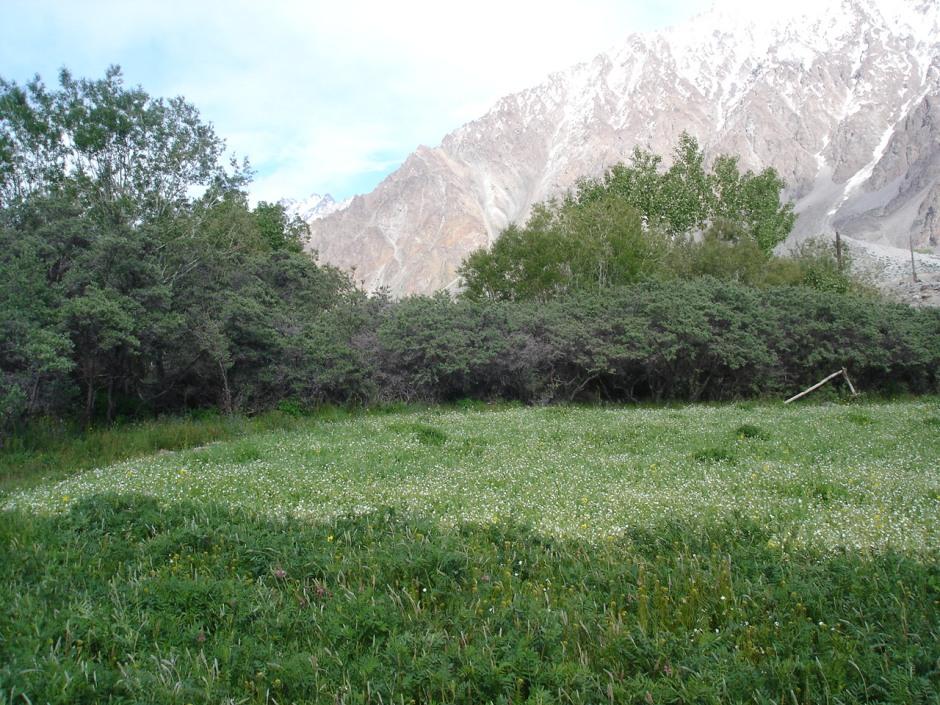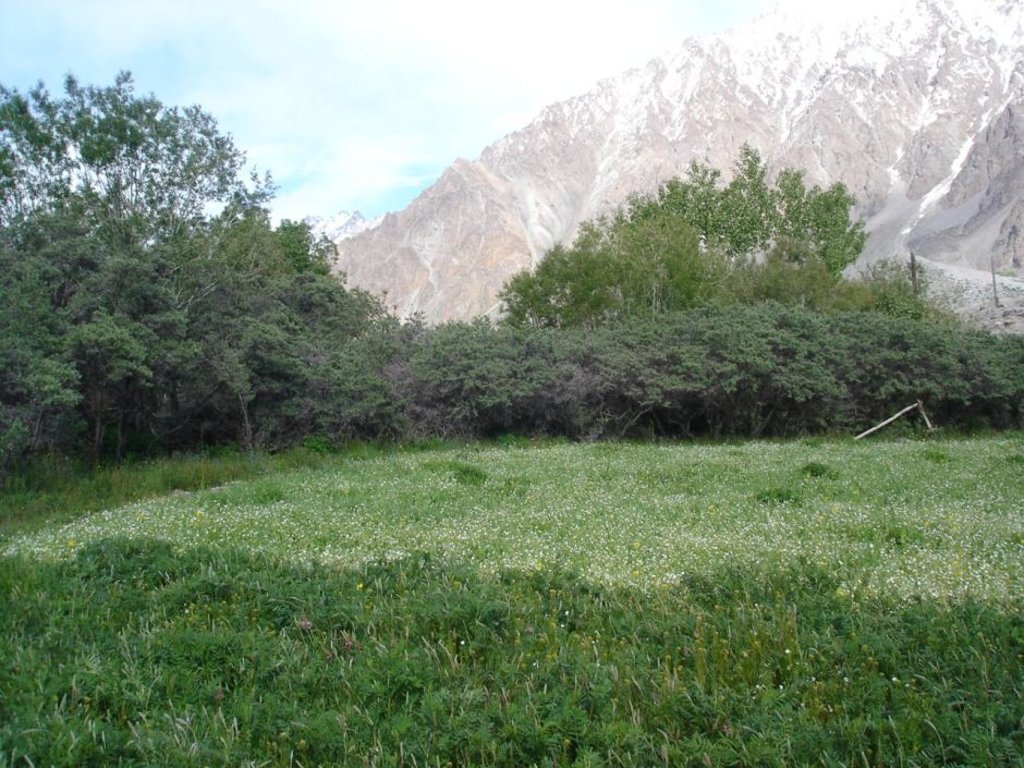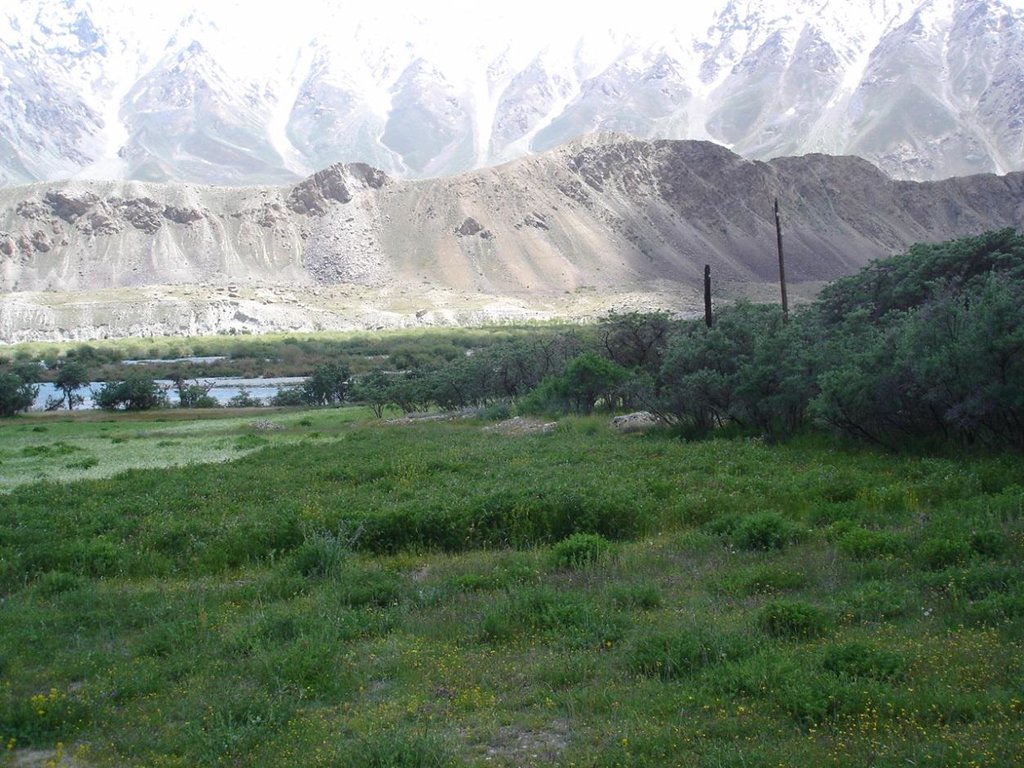Agroforestry in arid alpine zone above 3300 m asl [塔吉克斯坦]
- 创建:
- 更新:
- 编制者: Gulniso Nekushoeva
- 编辑者: –
- 审查者: David Streiff
technologies_1056 - 塔吉克斯坦
查看章节
全部展开 全部收起1. 一般信息
1.2 参与该技术评估和文件编制的资源人员和机构的联系方式
SLM专业人员:
有助于对技术进行记录/评估的机构名称(如相关)
Tajik Soil Insitute (Tajik Soil Institute) - 塔吉克斯坦有助于对技术进行记录/评估的机构名称(如相关)
Tajik Academy of Agricultural Sciences (Tajik Academy of Agricultural Sciences) - 塔吉克斯坦1.3 关于使用通过WOCAT记录的数据的条件
(现场)数据是什么时候汇编的?:
05/07/2010
编制者和关键资源人员接受有关使用通过WOCAT记录数据的条件。:
是
2. SLM技术的说明
2.1 技术简介
技术定义:
Cultivation of grain, potatoes and forage crops (esparzet) under the protection of windbreak live fence in the zone of risky agriculture (in the arid highlands traditional livestock zone of the Pamirs) above 3300m a.s.l
2.2 技术的详细说明
说明:
Purpose of the Technology: Increase the possibility of subsistence grain, potatoes and fodder. Reduce the dependence of yield of sharp daily fluctuations of temperature, cold winds and frost
2.3 技术照片
2.5 已应用该技术的、本评估所涵盖的国家/地区/地点
国家:
塔吉克斯坦
区域/州/省:
Tajikistan/ GBAO
有关地点的进一步说明:
Shugnan/ Vankala, v.Bachor
Map
×2.6 实施日期
如果不知道确切的年份,请说明大概的日期:
- 不到10年前(最近)
2.7 技术介绍
详细说明该技术是如何引入的:
- 通过土地使用者的创新
注释(项目类型等):
sowing of cereals and potatoes in a frame of trees had started 18 years ago, and sowing esparzet on third part of their land began in 2008, seeing in the center of Jamoat Vankala esparzet that have been produced through MSDSP, swapped seeds and planted
3. SLM技术的分类
3.1 该技术的主要目的
- 改良生产
3.2 应用该技术的当前土地利用类型

农田
- 一年一作
- 多年一作(非木材)
- 乔木与灌木的种植

混合(作物/放牧/树木),包括农林
- 农林业
注释:
Major land use problems (compiler’s opinion): low natural fertility of the stony shallow soils, short growing season, the zone of risky agriculture, farming is not possible without irrigation, despite the low temperatures
Major land use problems (land users’ perception): low temperatures at night in growing period , often leading to freezing of potato and grain maturation ..
Future (final) land use (after implementation of SLM Technology): Mixed: Mf: Agroforestry
如果由于技术的实施而导致土地用途发生变化,则在技术实施前说明土地利的用途。:
Grazing land: Ge: Extensive grazing land
3.3 有关土地利用的更多信息
该技术所应用土地的供水:
- 充分灌溉
每年的生长季节数:
- 1
具体说明:
Longest growing period in days: 90Longest growing period from month to month: June-August
3.4 该技术所属的SLM组
- 农业林学
- 防风林/防护林带
3.5 技术传播
具体说明该技术的分布:
- 均匀地分布在一个区域
如果该技术均匀地分布在一个区域上,请注明覆盖的大致区域。:
- < 0.1 平方千米(10 公顷)
注释:
Total area covered by the SLM Technology is 0.015 m2.
farmer's land is composed of several disparate fields, rather than one large area
3.6 包含该技术的可持续土地管理措施

农艺措施
- A1:植被和土壤覆盖层

植物措施
- V1:乔木和灌木覆盖层

结构措施
- S3:分级沟渠、渠道、水道

管理措施
- M1:改变土地使用类型
注释:
Main measures: agronomic measures, vegetative measures, structural measures, management measures
Type of agronomic measures: better crop cover, cover cropping, manure / compost / residues, furrows (drainage, irrigation)
Type of vegetative measures: aligned: -against wind, aligned: -along boundary
3.7 该技术强调的主要土地退化类型

化学性土壤退化
- Cn:肥力下降和有机质含量下降(非侵蚀所致)

生物性退化
- Bc:植被覆盖的减少
- Bq:数量/生物量减少

水质恶化
- Ha:干旱化
注释:
Main type of degradation addressed: Bc: reduction of vegetation cover, Bq: quantity / biomass decline
Secondary types of degradation addressed: Cn: fertility decline and reduced organic matter content, Ha: aridification
Main causes of degradation: deforestation / removal of natural vegetation (incl. forest fires) (lack of electricity and a long winter forced people to cut most of trees), over-exploitation of vegetation for domestic use (food unsecurity), overgrazing (because of the inability to sent livestock to remote pastures in Murgab), change in temperature (frequent frosts in the vegetation season lead to the eradication (t° variability)), population pressure (Because of need for subsistence there is intense pressure on arable land), poverty / wealth (Basically, all people are poor)
Secondary causes of degradation: soil management (The need for subsistence from 92th forced people to do farming), droughts (High aridity, minimum precipitation. forced to irrigate), labour availability (work is only in 1-9 classes school and on little ambulatory.), inputs and infrastructure: (roads, markets, distribution of water points, other, …) (complete isolation in winter, bad roads, no access to the market), education, access to knowledge and support services (There is a school until 9 class), war and conflicts (after the crisis of the 90s and the civil war forced to subsistence)
3.8 防止、减少或恢复土地退化
具体数量名该技术与土地退化有关的目标:
- 减少土地退化
注释:
Secondary goals: prevention of land degradation, rehabilitation / reclamation of denuded land
4. 技术规范、实施活动、投入和成本
4.1 该技术的技术图纸
作者:
Gulniso Nekushoeva, Dushanbe, Tajikistan
4.2 技术规范/技术图纸说明
Technical knowledge required for land users: moderate
Main technical functions: improvement of ground cover, improvement of surface structure (crusting, sealing), increase in organic matter, increase in nutrient availability (supply, recycling,…), reduction in wind speed, increase of biomass (quantity)
Secondary technical functions: increase of surface roughness, improvement of topsoil structure (compaction), stabilisation of soil (eg by tree roots against land slides), increase / maintain water stored in soil, water harvesting / increase water supply, promotion of vegetation species and varieties (quality, eg palatable fodder), spatial arrangement and diversification of land use
Better crop cover
Material/ species: barley
Quantity/ density: 200kg/ha
Manure / compost / residues
Material/ species: manure
Quantity/ density: 4t/ha
Furrows (drainage, irrigation)
Material/ species: irrigation canals net
Quantity/ density: 200/ha
Aligned: -against wind
Vegetative material: T : trees / shrubs
Spacing between rows / strips / blocks (m): 1
Vertical interval within rows / strips / blocks (m): 1
Aligned: -along boundary
Vegetative material: T : trees / shrubs
Waterway
Material: Earth
Trees/ shrubs species: T- sea buckthorn, in the begining - planted
Perennial crops species: C-esparzet on 1\3 of the field
Slope (which determines the spacing indicated above): 5-8%
4.3 有关投入和成本计算的一般信息
其它/国家货币(具体说明):
Somoni
注明美元与当地货币的汇率(如相关):1美元=:
4.52
注明雇用劳工的每日平均工资成本:
30
4.4 技术建立活动
| 活动 | 措施类型 | 时间 | |
|---|---|---|---|
| 1. | Clean up the plot of the stones and shrubs | 植物性的 | |
| 2. | plowing | 植物性的 | |
| 3. | manuring | 植物性的 | |
| 4. | Sowing of barley, rye | 植物性的 | |
| 5. | Planting potatoes | 植物性的 | |
| 6. | preparing sea-buckthorn seedlings | 植物性的 | spring |
| 7. | bringing and putting manure in the holes | 植物性的 | end of spring |
| 8. | manure | 植物性的 | |
| 9. | planting seedlings along the irrigation canal | 植物性的 | planting seedlings along the irrigation canal |
| 10. | irrigation of the seedlings | 植物性的 |
4.5 技术建立所需要的费用和投入
| 对投入进行具体说明 | 单位 | 数量 | 单位成本 | 每项投入的总成本 | 土地使用者承担的成本% | |
|---|---|---|---|---|---|---|
| 劳动力 | Cleaning up the plot | Persons/day | 4.0 | 30.0 | 120.0 | 100.0 |
| 劳动力 | Plowing | Persons/day | 6.0 | 30.0 | 180.0 | 100.0 |
| 劳动力 | Manuring | Persons/day | 7.0 | 30.0 | 210.0 | 100.0 |
| 劳动力 | Preparing sea-buckthorn | Persons/day | 3.0 | 35.0 | 105.0 | 100.0 |
| 植物材料 | Barley rye seeds | ha | 1.0 | 430.0 | 430.0 | 100.0 |
| 植物材料 | Potatoe seeds | ha | 1.0 | 110.0 | 110.0 | 100.0 |
| 肥料和杀菌剂 | Manure | kg | 400.0 | 0.0625 | 25.0 | |
| 其它 | Labour: Bringing and putting manure in the holes | Persons/day | 2.0 | 35.0 | 70.0 | 100.0 |
| 其它 | Labour: Planting seedlings along the irrigation cana | Persons/day | 4.0 | 35.0 | 140.0 | 100.0 |
| 其它 | Labour: Irrigation of the seedlings | Persons/day | 1.0 | 35.0 | 35.0 | 100.0 |
| 技术建立所需总成本 | 1425.0 | |||||
4.6 维护/经常性活动
| 活动 | 措施类型 | 时间/频率 | |
|---|---|---|---|
| 1. | irrigation of the crop fields | 农业学的 | during growing/ |
| 2. | irrigation of potatoes field | 农业学的 | during growing/ |
| 3. | weeding of potatoes field | 农业学的 | during growing/2-3time |
| 4. | harvesting potatoes | 农业学的 | september/every year |
| 5. | harvesting crops | 农业学的 | september/every year |
| 6. | irrigation of bushes | 植物性的 | |
| 7. | pruning and cutting the brunches | 植物性的 | |
| 8. | mowing the natural grass | 植物性的 |
4.7 维护/经常性活动所需要的费用和投入(每年)
| 对投入进行具体说明 | 单位 | 数量 | 单位成本 | 每项投入的总成本 | 土地使用者承担的成本% | |
|---|---|---|---|---|---|---|
| 劳动力 | Weeding / harvesting of potatoes field | Persons/day | 4.0 | 30.0 | 120.0 | 100.0 |
| 劳动力 | Harvesting crops | Persons/day | 6.0 | 30.0 | 180.0 | 100.0 |
| 技术维护所需总成本 | 300.0 | |||||
注释:
Machinery/ tools: shovel, shears,axe
5. 自然和人文环境
5.2 地形
平均坡度:
- 水平(0-2%)
- 缓降(3-5%)
- 平缓(6-10%)
- 滚坡(11-15%)
- 崎岖(16-30%)
- 陡峭(31-60%)
- 非常陡峭(>60%)
地形:
- 高原/平原
- 山脊
- 山坡
- 山地斜坡
- 麓坡
- 谷底
垂直分布带:
- 0-100 m a.s.l.
- 101-500 m a.s.l.
- 501-1,000 m a.s.l.
- 1,001-1,500 m a.s.l.
- 1,501-2,000 m a.s.l.
- 2,001-2,500 m a.s.l.
- 2,501-3,000 m a.s.l.
- 3,001-4,000 m a.s.l.
- > 4,000 m a.s.l.
关于地形的注释和进一步规范:
Altitudinal zone: 3300m
5.3 土壤
平均土层深度:
- 非常浅(0-20厘米)
- 浅(21-50厘米)
- 中等深度(51-80厘米)
- 深(81-120厘米)
- 非常深(> 120厘米)
如有可能,附上完整的土壤描述或具体说明可用的信息,例如土壤类型、土壤酸碱度、阳离子交换能力、氮、盐度等。:
Soil drainage / infiltration is good
5.4 水资源可用性和质量
水质(未处理):
良好饮用水
5.5 生物多样性
物种多样性:
- 中等
5.6 应用该技术的土地使用者的特征
生产系统的市场定位:
- 生计(自给)
相对财富水平:
- 贫瘠
- 平均水平
个人或集体:
- 个人/家庭
机械化水平:
- 手工作业
- 畜力牵引
性别:
- 女人
- 男人
说明土地使用者的其他有关特征:
Land users applying the Technology are mainly common / average land users
Population density: < 10 persons/km2
5.7 应用该技术的土地使用者拥有或租用的平均土地面积
- < 0.5 公顷
- 0.5-1 公顷
- 1-2 公顷
- 2-5公顷
- 5-15公顷
- 15-50公顷
- 50-100公顷
- 100-500公顷
- 500-1,000公顷
- 1,000-10,000公顷
- > 10,000公顷
这被认为是小规模、中规模还是大规模的(参照当地实际情况)?:
- 小规模的
5.8 土地所有权、土地使用权和水使用权
土地所有权:
- 州
土地使用权:
- 租赁
用水权:
- 自由进入(无组织)
5.9 进入服务和基础设施的通道
健康:
- 贫瘠
- 适度的
- 好
教育:
- 贫瘠
- 适度的
- 好
技术援助:
- 贫瘠
- 适度的
- 好
就业(例如非农):
- 贫瘠
- 适度的
- 好
市场:
- 贫瘠
- 适度的
- 好
能源:
- 贫瘠
- 适度的
- 好
道路和交通:
- 贫瘠
- 适度的
- 好
饮用水和卫生设施:
- 贫瘠
- 适度的
- 好
金融服务:
- 贫瘠
- 适度的
- 好
6. 影响和结论性说明
6.1 该技术的现场影响
社会经济效应
生产
作物生产
饲料生产
饲料质量
木材生产
生产故障风险
产品多样性
生产区域
能源生产
收入和成本
农业收入
收入来源的多样性
社会文化影响
食品安全/自给自足
健康状况
SLM/土地退化知识
Livelihood and human well-being
生态影响
水循环/径流
蒸发
土壤
土壤水分
土壤覆盖层
土壤流失
土壤压实
养分循环/补给
土壤有机物/地下C
生物多样性:植被、动物
生物量/地上C
植物多样性
有益物种
减少气候和灾害风险
碳和温室气体的排放
风速
6.3 技术对渐变气候以及与气候相关的极端情况/灾害的暴露和敏感性(土地使用者认为的极端情况/灾害)
渐变气候
渐变气候
| 季节 | 气候变化/极端天气的类型 | 该技术是如何应对的? | |
|---|---|---|---|
| 年温度 | 增加 | 好 |
气候有关的极端情况(灾害)
气象灾害
| 该技术是如何应对的? | |
|---|---|
| 局地风暴 | 好 |
其他气候相关的后果
其他气候相关的后果
| 该技术是如何应对的? | |
|---|---|
| 缩短生长期 | 不好 |
6.4 成本效益分析
技术收益与技术建立成本相比如何(从土地使用者的角度看)?
短期回报:
稍微积极
长期回报:
非常积极
技术收益与技术维护成本/经常性成本相比如何(从土地使用者的角度看)?
短期回报:
稍微积极
长期回报:
非常积极
6.5 技术采用
- 大于 50%
如若可行,进行量化(住户数量和/或覆盖面积):
1 housefold in an area of 1.5 ha
在所有采用这项技术的人当中,有多少人是自发地采用该技术,即未获得任何物质奖励/付款?:
- 90-100%
链接和模块
全部展开 全部收起链接
无链接
模块
无模块





